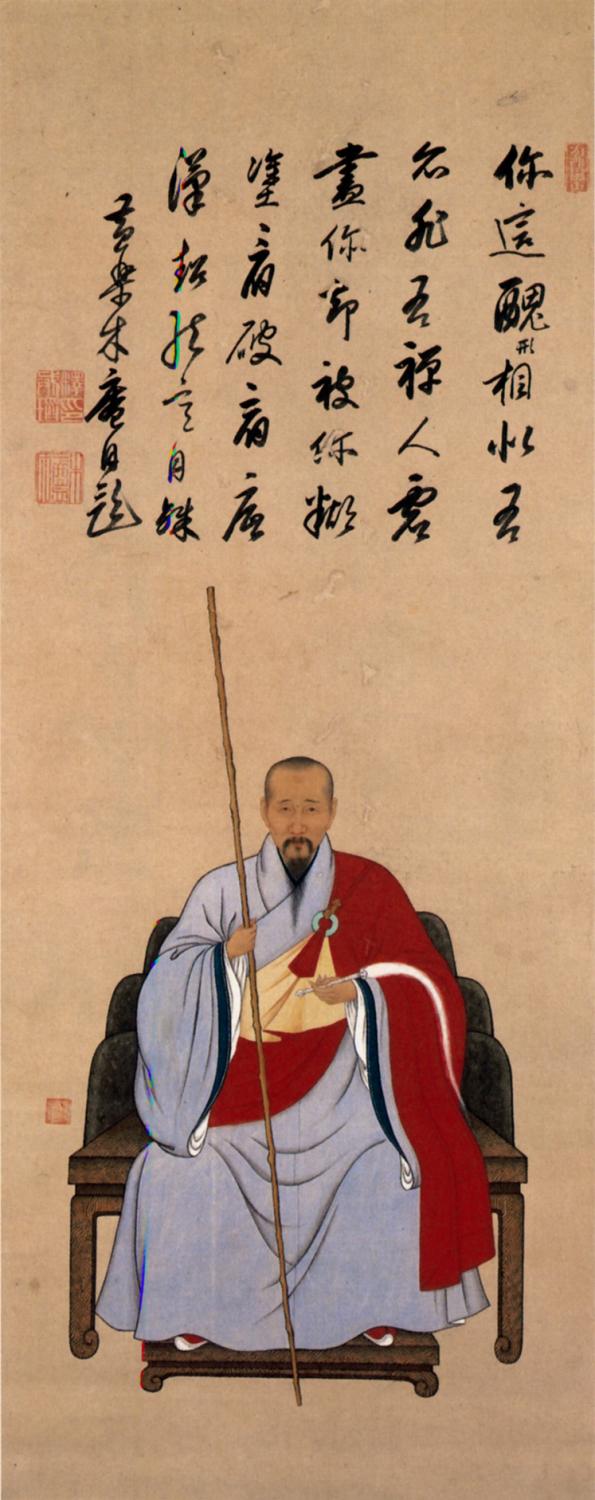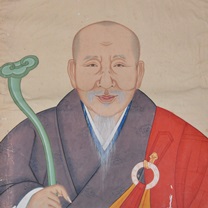ZEN MESTEREK ZEN MASTERS
« Zen főoldal
« vissza a Terebess Online nyitólapjára
木菴性瑫 Muan Xingtao (1611-1684)
(Rōmaji:) Mokuan Shōtō

喜多道矩 (長兵衛) Kita Dōku (Chōbei) (active ca. 1657-63), Portrait of Muan Xingtao.
Right scroll of a triptych with Yinyuan Longqi (1592-1673) and Jifei Ruyi (1616-71). Self-eulogy. Seal: “Chō.”
From a set of three hanging scrolls, ink and colours on paper, each 112.5 x 44.9 cm. Kobe City Museum.

Mu’an Xingtao. (J. Mokuan Shōtō; K. Mogam Sŏngdo 木菴性瑫) (1611–1684).
Chinese CHAN master, calligrapher, and pioneer of the ŌBAKUSHŪ in Japan.
He was a native of Quanzhou in present-day Fujian province. After his novice
ordination at the age of eighteen, Mu’an received the full monastic precepts from
the monk Yongjue Yuanxian (1578–1657) on Mt. Gu (present-day Fujian
province). Mu’an visited the eminent Chan master MIYUN YUANWU before he
returned to Yongjue, under whom he is said to have attained awakening. Later,
Mu’an continued his studies under FEIYIN TONGRONG and his disciple
YINYUAN LONGQI at the monastery of Wanfusi on Mt. Huangbo (present-day
Fujian province). Mu’an eventually became Yinyuan’s disciple and inherited his
lineage. In 1655, Mu’an arrived in Nagasaki, Japan, and began his residence at the
monastery of Fukusaiji. In 1661, Mu’an followed Yinyuan to his new monastery
of MANPUKUJI in Uji. Three years later, Mu’an succeeded Yinyuan as the
abbot of the monastery, and the next year he oversaw the ordination of monks at
the triple-precept platform ceremony (sandan kaie). In 1670, he received the
purple robe, and later with the support of the shōgun Tokugawa Ietsuna (1639–
1680), he established the monastery of Zuishōji in Edo. In 1675, he turned over
the administration of Zuishōji to his disciple Tetsugyū Dōki (1628–1700) and that
of Manpukuji to Huilin Xingji (1609–1681).
The Princeton Dictionary of Buddhism (2014)
PDF: Muan Xingtao: An Obaku Zen Master of the Seventeenth Century in China and Japan
by Shyling Glaze
The University of Arizona, 2011
Muan Xingtao was a prominent Chan master of the seventeenth century. This study attempts to examine his religious and cultural legacy and his numerous accomplishments. Among his many achievements were his successful consolidation of the Obaku headquarters of Manpukuji in Japan and cultivation of many Japanese dharma heirs which greatly expanded the Obaku's territories. He was praised for his artistic abilities in painting and calligraphy which led to the Japanese designating him as one of the “Obaku sanpitsu 黄檗三筆”. He earned the highest religious honors of the purple robe and obtained the patronage from the shogun and Japanese elite. He characteristically manifested the virtues of filial piety and loyalty and transmitted the Ming style of Buddhist teachings, which placed more emphasis on the lay believers, nenbutsu and monastic discipline to Japan. His life represented the religious influence achieved through the interconnection between nations.
Mu'an Xingtao’s Dharma Lineage
[...]
菩提達磨 Bodhidharma, Putidamo (Bodaidaruma ?-532/5)
大祖慧可 Dazu Huike (Taiso Eka 487-593)
鑑智僧璨 Jianzhi Sengcan (Kanchi Sōsan ?-606)
大毉道信 Dayi Daoxin (Daii Dōshin 580-651)
大滿弘忍 Daman Hongren (Daiman Kōnin 601-674)
大鑑慧能 Dajian Huineng (Daikan Enō 638-713)
南嶽懷讓 Nanyue Huairang (Nangaku Ejō 677-744)
馬祖道一 Mazu Daoyi (Baso Dōitsu 709-788)
百丈懷海 Baizhang Huaihai (Hyakujō Ekai 750-814)
黃蘗希運 Huangbo Xiyun (Ōbaku Kiun ?-850)
臨濟義玄 Linji Yixuan (Rinzai Gigen ?-866)
興化存獎 Xinghua Cunjiang (Kōke Zonshō 830-888)
南院慧顒 Nanyuan Huiyong (Nan'in Egyō ?-952)
風穴延沼 Fengxue Yanzhao (Fuketsu Enshō 896-973)
首山省念 Shoushan Shengnian (Shuzan Shōnen 926-993)
汾陽善昭 Fenyang Shanzhao (Fun'yo Zenshō 947-1024)
石霜/慈明 楚圓 Shishuang/Ciming Chuyuan (Sekisō/Jimei Soen 986-1039)
楊岐方會 Yangqi Fanghui (Yōgi Hōe 992-1049)
白雲守端 Baiyun Shouduan (Hakuun Shutan 1025-1072)
五祖法演 Wuzu Fayan (Goso Hōen 1024-1104)
圜悟克勤 Yuanwu Keqin (Engo Kokugon 1063-1135)
虎丘紹隆 Huqiu Shaolong (Kukyū Jōryū 1077-1136)
應庵曇華 Yingan Tanhua (Ōan Donge 1103-1163)
密庵咸傑 Mian Xianjie (Mittan Kanketsu 1118-1186)
破庵祖先 Poan Zuxian (Hoan Sosen 1136–1211)
無準師範 Wuzhun Shifan (Bujun Shipan 1177–1249)
雪巖祖欽 Xueyan Zuqin (Seggan Sokin (1215–1287)
高峰原妙 Gaofeng Yuanmiao (Kōhō Gemmyō 1238-1295)
中峯明本 Zhongfeng Mingben (Chūhō Myōhon 1263–1323)
千巖元長 Qianyan Yuanzhang (Sengan Genchō 1284–1357)
萬峰時蔚 Wanfeng Shiwei (Manhō Jijō 1303–1381)
寶藏普持 Baozhang Puchi (Hōzō Fuji ?-?)
虗白慧旵 Xubai Huichan (Kihaku Egaku 1372–1441)
海舟普慈 Haizhou Puci (Kaishū Eiji 1355-1450)
寶峰明瑄 Baofeng Mingxuan (Hōbō Myōken ?-1472)
天奇本瑞 Tianqi Benrui (Tenki Honzui ?-1508)
無聞正聰 Wuwen Mingcong (Mubun Shōsō (?-1543)
月心德寶 Xiaoyan Debao (Getsushin Tokuhō 1512–1581)
幻有正傳 Huanyou Zhengchuan (Genyū Shōden 1549-1614)
蜜雲円悟 Miyun Yuanwu (Mitsu'un Engo 1566-1642)
費隠通容 Feiyin Tongrong (Hi'in Tsuyo 1593-1661)
隠元隆琦 Yinyuan Longqi (Ingen Ryuki 1592-1673)
木庵性瑫 Mu'an Xingtao (Mokuan Shōtō 1611-1684)